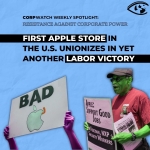US: FCC Close to Easing Media Caps
Giant Firms Want to Own More Outlets
The Federal Communications Commission is moving closer to easing its media ownership caps, including regulations that now limit how many television stations a network may own, or whether a company can own a newspaper and a television station in the same city.
Opponents are waging a frantic battle to forestall FCC action. They fear that a handful of media giants will gobble up even more of the print and broadcast spectrum.
Dissident FCC Commissioner Michael Copps, who wants to slow the process, will speak at two events in the Bay Area today -- one at Dominican University in San Rafael hosted by Rep. Lynn Woolsey, D-Petaluma, and one at the Commonwealth Club in San Francisco.
''We're going to have a handful of people providing the news for the entire country,'' Woolsey said. ''We will be losing the diversity of intellect and ideas and opinions. We'll be cutting off minority opinions and dissent, and it's not our founding fathers intended.''
The FCC takes a critical step this week, when commissioners receive specific proposals for deregulation. The proposals, which are not to be released, will come up for a vote June 2.
In a phone interview last week, Copps said that of roughly 18,000 public comments on the proposed changes -- not counting the hundred or so from media companies or organized coalitions -- ''I haven't seen any that say, 'Let's relax the rules further.' ''
''In the media landscape we have now, if a new Ted Turner sprang from the earth with a new idea for CNN, I don't know that he could go very far,'' Copps said.
On the other side of the debate are the biggest media companies and the Republicans who control the FCC.
They argue that the media world has exploded with options, with new cable networks and Internet sites sprouting up all the time. The companies have also had some success fighting the current rules in court, which has spurred the FCC to action.
''The court says, 'Look, any time you have an ownership rule that restricts an entity's right to buy a radio station, broadcast (television) station or a newspaper, you are in effect restricting their First Amendment right to free speech. You need to explain to us what those governmental interests are.' '' said FCC Commissioner Kathleen Abernathy.
Hearst Corp., the owner of The Chronicle, is among the companies that has asked the FCC to ease restrictions.
The proposals will likely include some sort of ''diversity index,'' Abernathy said, which will help the commission calculate how many media outlets one company may own in a given market.
Last week, 285 academics, including many leading journalism professors, sent a letter to the FCC questioning such an index.
''We have grave doubts that any single measure can effectively analyze the complexities of the media marketplace, in terms of its impact on journalism, citizen access to information, and competition,'' the letter said.
The Los Angeles Times, citing unidentified sources, reported that the proposals would allow TV broadcasters to reach 45 percent of U.S. households rather than the current 35 percent, and they would allow a single company to own as many as three television stations and one newspaper in large markets.
Partisan Politics
Even the nature of the debate has fallen victim to the FCC's partisan politics. While the two Democratic commissioners, Copps and Jeffrey Adelstein, argued for public hearings around the country, FCC Chairman Michael Powell said such hearings were not necessary given the outpouring of commentary reaching the commission.
Copps and Adelstein conducted unofficial hearings anyway, including one in San Francisco last month that attracted more than 500 people.
Jeff Perlstein, executive director of Media Alliance in San Francisco, one of the organizers of the hearing, said most of those speaking at the hearing opposed relaxing the rules, and urged more public input.
Media Alliance, along with several other advocacy organizations, plans to ask the U.S. Senate Commerce Committee to exercise its powers of oversight and either block or undo any FCC action that lifts ownership limits.
Andrea Buffa, a Media Alliance board member and the national co-chair of United for Peace and Justice, an umbrella organization formed to protest the war in Iraq, said they'll have the backing of an energized anti-war movement that is ready to take on the issue of big media.
''We were really unhappy with the media coverage of the war and the anti-war movement, especially television coverage that seemed like cheerleading for the war effort and didn't reflect reality,'' Buffa said. ''(U.S. Secretary of State) Colin Powell was spearheading the war and his son Michael Powell at the FCC is calling for rule changes that could change many regulations that govern corporate media.''
Organizations such as Global Exchange and MoveOn.org are joining the effort at the FCC.
''My understanding is the FCC is supposed to regulate the airwaves in the public interest,'' Buffa said. ''If the FCC and Michael Powell interpret the public interest as huge corporations that want to buy up channels, they can do that. We think you need a diversity of media outlets and a diversity of opinion so people can make informed, important decisions.''
Mandate of Diversity
FCC Commissioner Abernathy acknowledges the commission's mandate to protect diversity, local news and competition. But she says the FCC's job is to pick a number in each market that companies and consumers can live with. ''We're coming up with numbers that are going to be reasonable and justifiable,'' Abernathy said. ''I have no doubt reasonable minds can differ.''
She also cast a skeptical eye on the contention, raised by Media Alliance's Perlstein and others, that five or six big media companies control 75 to 80 percent of Americans' media diets.
She cited studies that showed the largest companies don't control 75 percent of the channels, but 25 percent of the broadcast and cable channels. Instead, viewers are watching those companies' channels - overwhelmingly selecting them over other choices.
''That means they're doing a pretty good job of catching eyeballs,'' Abernathy said, meaning that consumers have choices.
###
__________________________________________________________________________
Media giants already own scores of firms
The media landscape doesn't look like an industry with many limits. Consider the breadth of just partial lists of some of the largest companies' holdings (complete lists are available at the Columbia Journalism Review's Web site, www.cjr.org/owners): -- AOL Time Warner: The largest Internet service provider (37 million customers), the second largest cable company, HBO, CNN, TNT, TBS, the WB Network, Warner Bros. Studios, Castle Rock Entertainment, New Line Cinema, music labels Atlantic, Rhino, Elektra and Warner Bros., book publishers Little Brown & Co., Time Life, and Book of the Month Club, and the largest U.S. magazine company, publisher of Time, People, Sports Illustrated, Fortune, Money, Entertainment Weekly, and many others, and the Atlanta Braves, Hawks and Thrashers sports teams.
-- Viacom: CBS and UPN networks, MTV, VH1, Showtime, Nickelodeon, Comedy Central, BET; Infinity, the second largest radio network (including KCBS, KLLC and KITS in the Bay Area); 34 television stations (including KPIX-TV, Channel 5 in the Bay Area); Paramount Pictures, Simon & Schuster book publisher, Spelling Entertainment, and other entertainment and publishing holdings.
-- News Corp.: The Fox network and Fox News Channel, 22 television stations, 20th Century Fox film and television studios, TV Guide, the Weekly Standard, the New York Post (and other newspapers in England and Australia), book publishers Harper Collins and William Morrow, the Los Angeles Dodgers, with stakes in the Los Angeles Kings and Lakers and New York Knicks and Rangers sports teams.
-- Walt Disney Corp.: ABC television network, 10 television stations and 53 radio stations (including KGO TV and radio in the Bay Area, and KSFO-AM); Disney Channel and stakes in A&E, ESPN, the History Channel, Lifetime and other cable channels; Walt Disney Pictures, Touchstone Pictures, Miramax Films; Buena Vista Music Group; Hyperion and Miramax books; theme parks and a cruise line.
-- Hearst Corp., the owner of The Chronicle, is among the companies that have asked the FCC to ease restrictions. Privately held Hearst owns 12 daily newspapers, 17 U.S. magazines, 27 television stations, and stakes in A&E, ESPN, the History Channel, Lifetime and other cable channels, among other media holdings.
______________________________________________________________________________
FCC Regulations
-- Local TV ownership: The ''duopoly'' rule allows a company to own two stations in one market only under certain conditions, such as whether there are at least eight stations remaining in the market.
-- TV-radio cross-ownership: Companies that own television stations are limited in how many radio stations they can own in a market, depending on how many other media outlets there are in the market.
-- Broadcast-newspaper cross-ownership: One company may not own a newspaper and a television or radio station in the same market.
-- Dual network limit: A company may not own two of the top four television networks.
-- Local radio ownership cap: One company may not own more than eight radio stations in one market, or four in small markets.
-- National TV ownership cap: No company may own television stations that serve more than 35 percent of U.S. households.
-- Cable ownership: No cable network may serve more than 30 percent of U.S. households, nor may a cable company carry affiliated programming on more than 40 percent of its channels.
(The FCC also had a rule banning a cable operator from carrying a television station that it owned, but a court struck it down. Courts have also ordered the FCC to review the national and local television ownership caps, and Congress has put other rules in play with its mandate for FCC review every two years.)
- 180 Media & Entertainment


